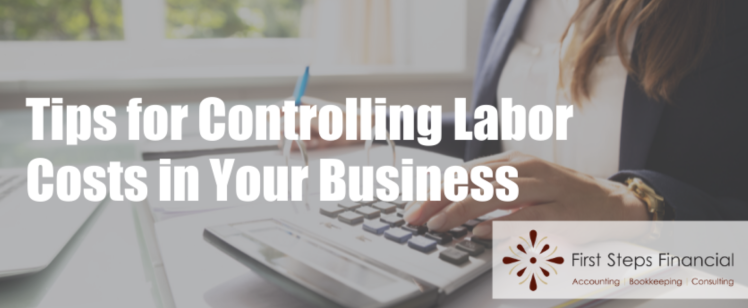-
Tips for Controlling Labor Costs in Your Business
For service businesses, labor costs are the largest expenses incurred in business operations. For many other types of businesses, the cost of labor is a large component of overall costs.
Controlling labor costs so they remain in line with what’s best for the organization is an important management function—and that’s why we’re here to help!
Here are several ways to control or reduce labor costs in your business.
- Encourage Employee Retention
If well-trained employees leave, you likely will have to replace them with inexperienced employees that need training. This results in a temporary loss of productivity. Some turnover can be good, but if turnover is too high, it can result in increased labor costs.
- Automate Tasks
Save labor by automating any repetitive tasks employees are still performing manually. While some automation might require extensive capital outlays, many systems can be implemented that are inexpensive and provide an immediate return on investment.
- Streamline Processes
Are you operating your business most efficiently? Or are employees still performing outdated tasks that have lost their meaning over time?
One place to look is the interface between departments. Is your sales team duplicating marketing’s efforts? Is customer service answering the same question without communicating to operations how it should be permanently fixed? Enhancing communications among employees throughout the company can cut down on labor costs.
- Train Employees
Make sure your employees have the training to do their jobs effectively. If they are using systems and other tools, make sure they have completed courses or certifications.
- Provide the Right Tools for the Job
Do employees have the tools they need to do the job well? If you’re giving them an abacus instead of the latest version of Microsoft Excel®, you can’t expect them to perform their best. This is an extreme example, but the importance of having the right tools can’t be overstated.
- Cross-Train Employees
If an employee is out sick, will a customer request sit around until that employee is back? Check to see if your employees can easily pick up a colleague’s work and fill in if their team member is out.
- Optimize Employee Schedules
In many industries, including restaurant and retail, employee scheduling can make the difference between profit and loss. Software can help you determine how many employees you need and at what times. Ensuring employees know when to come in and what to focus on when they clock in will go a long way toward increasing productivity.
In some cases, a shorter work week is a possibility that can drive lower labor costs.
- Outsource
Outsourcing may be cheaper than using employees on certain tasks, especially if you have tasks that require specialized knowledge or skills, or you might not need a full-time person. Outsourcing can also help you determine how long a task will take so you can plan better if you do decide to bring the activity in house.
- Review Compensation
Compare your company’s current salaries to the going market rate for salaries in your industry. Are your salaries in line? Adjust accordingly for future hires.
You can also consider different pay structures, such as commission-based, to better match performance to labor costs. Bonuses paid out in lieu of annual raises allow you to better manage accumulated pay raises in the case of long-term employees.
- Review Benefits
Employees love perks, but these perks can be costly. If necessary, this is an area in which expenses can be cut to reduce costs. This can include reviewing time-off policies, employer’s percentage share of 401(k) plan contributions, and additional health care coverage such as dental and vision.
Hiring part-time employees that are ineligible for benefits can also reduce labor costs.
- Cut Overtime Pay
If overtime pay is so high that you need to increase your headcount, then it’s too high. On the other hand, some overtime pay is fine if it avoids hiring a headcount you don’t fully need.
- Incentivize Workers
Try increasing productivity and results with incentives built into your compensation plan.
- Provide Remote Work Options
Studies show remote workers are more productive. Plus, overhead expenses such as rent, furniture, and utilities will plummet, saving expenses overall.
- Hire Smart from the Start
The saying is “Hire slow, fire fast.” Finding the right workers for your business is an art form. Interview, test, check background and references, and hire employees on a trial basis to be sure you have the best workers.
- Maintain a Safe Working Environment
Follow all of the regulatory requirements, but use common sense as well to ensure you have a safe workplace for employees.
- Understand the Accounting Side of Labor Costs
If you pay an employee $15 per hour, understand that your labor cost will be far more than $15. These are the things not included in that $15:
- Employer’s share of payroll taxes (Social Security and Medicare)
- Vacation and time off
- Paid holidays
- Workers compensation insurance
- Unemployment insurance (federal and state)
- Health care
- 401(k) matches
- Company picnics and events
- The cost of all other employee perks
The cost of onboarding and retaining an employee includes even more than labor costs and should allocate these expenses:
- Computer equipment and software applications
- Rent, utilities, furniture, parking spaces, building repair
- Employer-paid meals, snacks, and coffee
- Training
- Events and travel
- Meeting time and expenses (this deserves to be listed separately)
Employees make your business possible, but to maintain a business profit, labor costs must be kept in line. Try these ideas to help your team be more productive and keep your labor costs under control.
Looking for help tracking and reducing your labor costs? Reach out and let’s have a conversation!
Comments are closed.
- (609) 759-5881
- Contact us
